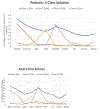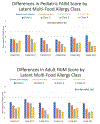The epidemiology of multifood allergy in the United States: A population-based study
- PMID: 36596337
- PMCID: PMC10217773
- DOI: 10.1016/j.anai.2022.12.031
The epidemiology of multifood allergy in the United States: A population-based study
Abstract
Background: Immunoglobulin E (IgE)-mediated food allergies (FAs) are increasingly common among US children and adults. Not only can living with FA impose considerable physical health impacts, but it also imposes economic burden and can negatively affect quality of life. Limited data indicate that allergy to multiple foods (multi-FA) also may be common, but much remains unknown about its distribution and determinants.
Objective: To characterize the prevalence, characteristics, determinants, psychosocial burden, and distribution of multi-FA among a large, nationally representative sample of US children and adults.
Methods: A US population-based survey was administered. Estimates of multi-FA prevalence, conditional frequencies of multi-FA combinations, and associated factors were derived. Latent class analyses were conducted using 9 dichotomized indicators of specific FA prevalence, which were used to determine factors associated with latent class membership and characterize FA-related psychosocial burden within each class.
Results: Surveys were completed for 38,408 children and 40,443 adults. Among children and adults meeting established symptom-report criteria for FA, an estimated 40% and 48% had multi-FA, respectively. Among pediatric and adult populations with convincing FAs, the lifetime reported prevalence of physician-diagnosed atopic comorbidities increased significantly as the number of reported current convincing FAs increased, as did the proportion reporting multi-FA-related health care utilization and higher perceived psychosocial burden. Latent class analyses suggested the existence of the following 4 key latent phenotypes of multi-FA: milk and egg-dominant, seafood-dominant, peanut and tree nut-dominant, and broadly multi-food allergic.
Conclusion: The US population-level burden of multi-FA is high among both children and adults, and data indicate the presence of 4 major phenotypes of multi-FA in both populations.
Copyright © 2022 American College of Allergy, Asthma & Immunology. Published by Elsevier Inc. All rights reserved.
Conflict of interest statement
Dr. Warren reports research support from the National Institutes of Health, Food Allergy Research & Education (FARE), and the Sunshine Charitable Foundation. He is currently employed by Northwestern University and is an Assistant Professor of Preventive Medicine at Northwestern University Feinberg School of Medicine.
Dr. Aktas was employed by Northwestern University at the time of this work, and she is currently employed by the National Institute of Allergy and Infectious Disease/NIH.
Dr. Gupta receives research support from the National Institutes of Health (NIH) (R21 ID # AI135705, R01 ID # AI130348, U01 ID # AI138907), Food Allergy Research & Education (FARE), Melchiorre Family Foundation, Sunshine Charitable Foundation, The Walder Foundation, UnitedHealth Group, Thermo Fisher Scientific, and Genentech. She serves as a medical consultant/advisor for Genentech, Novartis, Aimmune LLC, Allergenis LLC, and Food Allergy Research & Education (FARE). Dr. Gupta has ownership interest in Yobee Care, Inc. She is currently employed by Ann & Robert H. Lurie Children’s Hospital of Chicago and is a Professor of Pediatrics & Medicine at Northwestern University Feinberg School of Medicine.
The other authors have no potential conflicts to disclose.
Figures




Comment in
-
Multifood allergy: More than meets the eye.Ann Allergy Asthma Immunol. 2023 May;130(5):540-541. doi: 10.1016/j.anai.2023.01.038. Ann Allergy Asthma Immunol. 2023. PMID: 37137600 Free PMC article. No abstract available.
References
-
- Grabenhenrich L, Trendelenburg V, Bellach J, Yürek S, Reich A, Fiandor A, et al. Frequency of food allergy in school-aged children in eight European countries—The EuroPrevall-iFAAM birth cohort. Allergy. 2020. Sep;75(9):2294–308. - PubMed
-
- Lyons SA, Clausen M, Knulst AC, Ballmer-Weber BK, Fernandez-Rivas M, Barreales L, et al. Prevalence of food sensitization and food allergy in children across Europe. The Journal of Allergy and Clinical Immunology: In Practice. 2020. Sep 1;8(8):2736–46. - PubMed
-
- Warren CM, Otto AK, Walkner MM, Gupta RS. Quality of life among food allergic patients and their caregivers. Curr Allergy Asthma Rep. 2016. May; 16(5): 1–8. - PubMed
-
- Bilaver LA, Chadha AS, Doshi P, O’Dwyer L, Gupta RS. Economic burden of food allergy: a systematic review. Ann Allergy Asthma Immunol. 2019. Apr 1;122(4):373–80. - PubMed
Publication types
MeSH terms
Substances
Grants and funding
LinkOut - more resources
Full Text Sources
Medical
Research Materials
Miscellaneous

